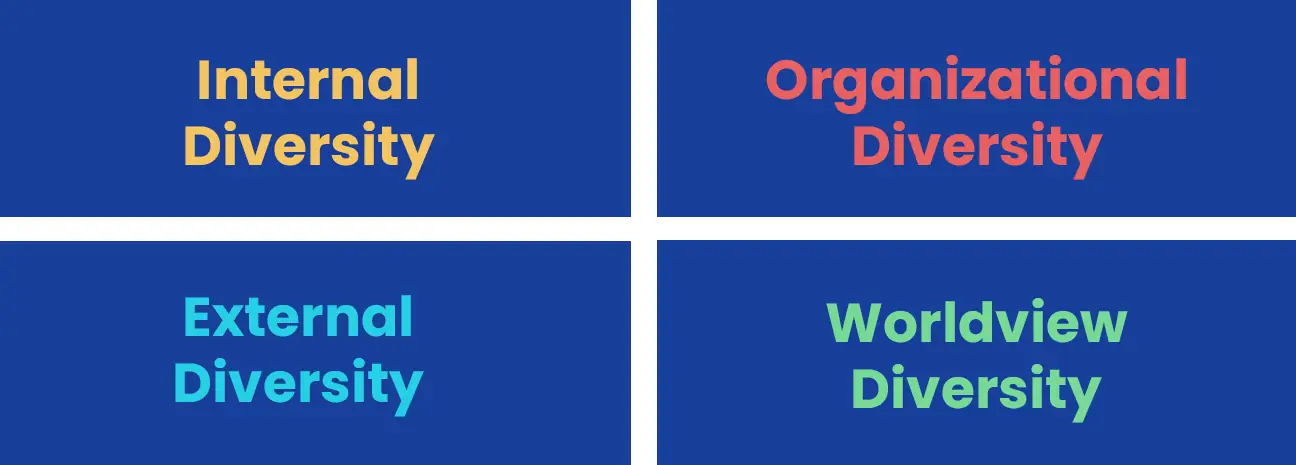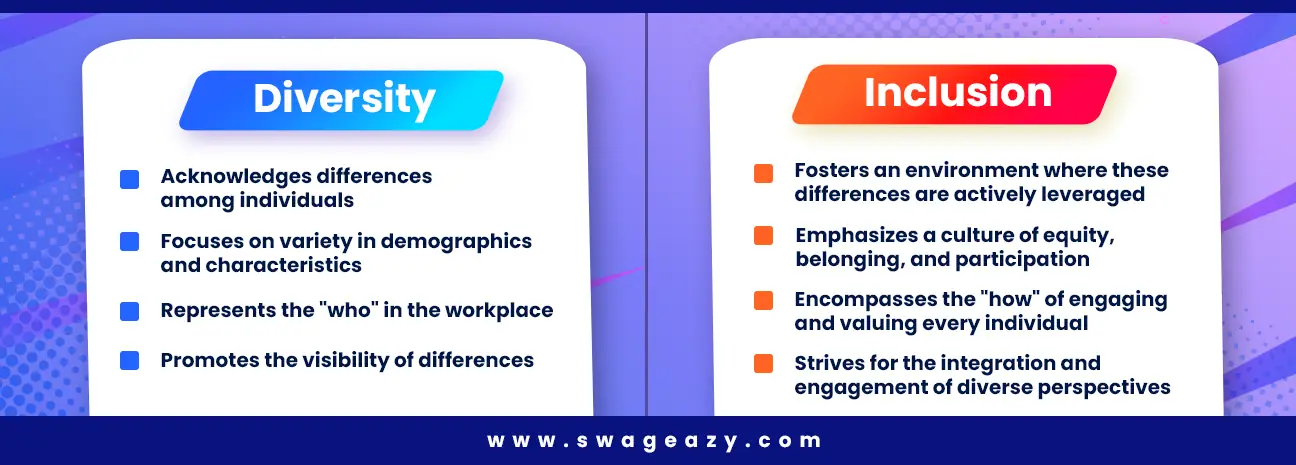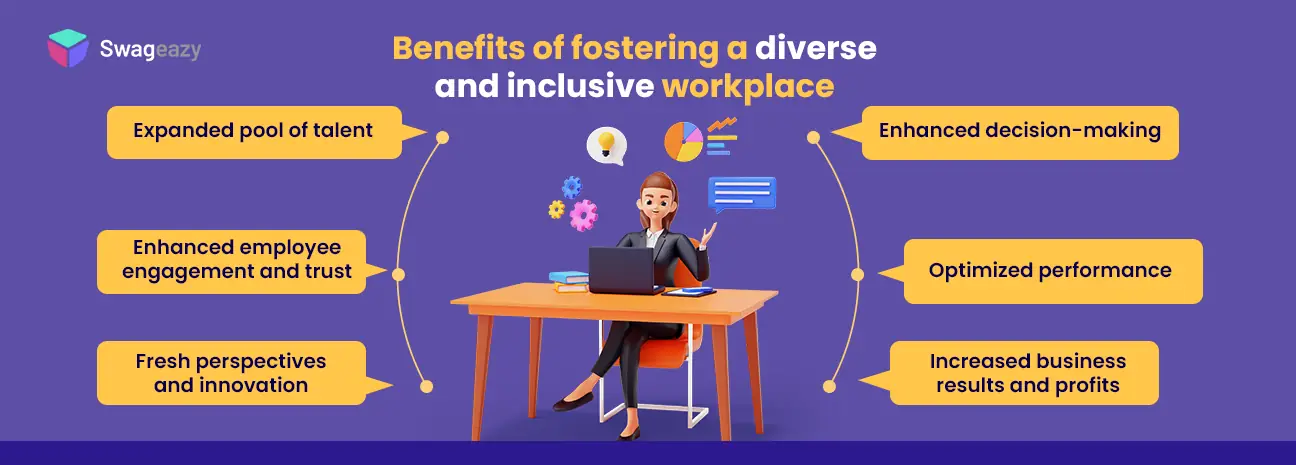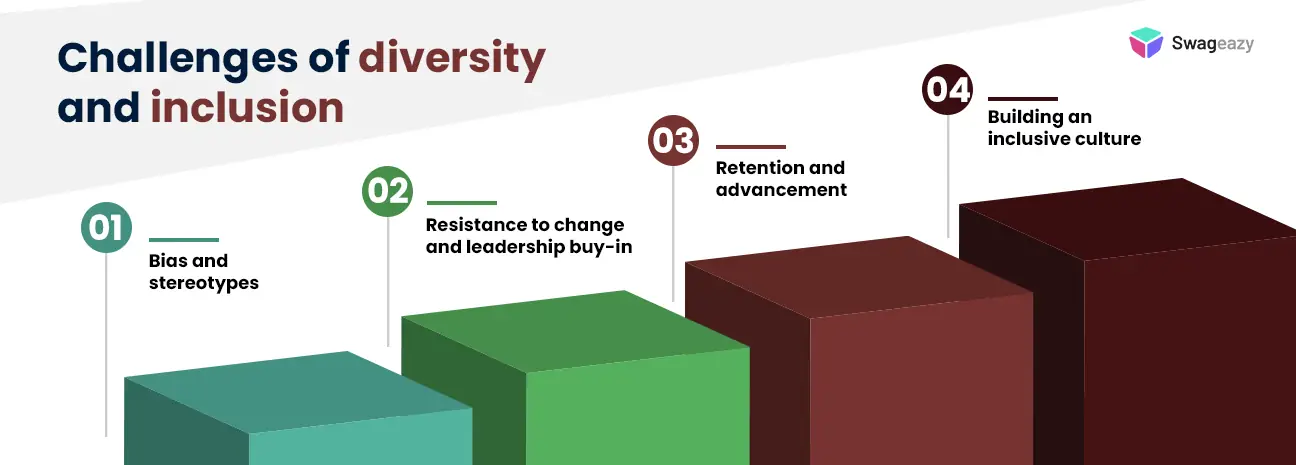A Thorough Look At Diversity And Inclusion In The Workplace

Today, the terms "diversity" and "inclusion" have transcended beyond buzzwords to become crucial pillars of organizational success. As companies strive to navigate a globalized and interconnected world, embracing diversity and fostering inclusion is a strategic necessity to scale your organization the right way up.
In this article, we’ll cover:
- What diversity and inclusion in a workplace is,
- The definitions and differences between diversity and inclusion,
- Core values and pillars of diversity and inclusion,
- Benefits of fostering a diverse and inclusive workplace,
- The challenges it comes with, and
- How to improve diversity and inclusion in your organization.
We’ve got a lot to cover, so let’s get right in!
What is diversity and inclusion in the workplace?
Diversity and inclusion in the workplace represent a commitment to acknowledging, respecting, and embracing the differences among individuals within an organization.
It's a strategic approach that goes beyond surface-level characteristics, recognizing and valuing unique perspectives, experiences, and backgrounds.
In essence, it's about creating an environment where everyone feels empowered, heard, and able to contribute their best, fostering a culture of innovation and collaboration.
While these terms are used in tandem, they are not the same thing, and to understand that, we’ll need to get into just that - what do ‘diversity’ and ‘inclusion’ mean?
What is diversity?
Diversity in the workplace encompasses the vast array of differences among individuals, extending well beyond the immediately visible traits such as race, gender, sexual orientation, geography, and ethnicity.
While these attributes represent the more apparent facets of diversity, it's crucial to recognize that diversity operates on a multi-dimensional scale.
With that in mind, diversity is categorized into 4 types.

- Internal Diversity: This refers to inherent traits like age, gender, ethnicity, and physical abilities. Internal diversity recognizes the visible and intrinsic differences that contribute to a rich tapestry within the workforce.
- External Diversity: External diversity involves factors influenced by external environments, including educational background, socioeconomic status, and geographical location. Understanding these external influences adds layers to appreciating the uniqueness each individual brings.
- Organizational Diversity: Within an organization, diversity extends to differences in job roles, departments, and levels of hierarchy. Embracing organizational diversity promotes collaboration among varied skill sets and perspectives.
- Worldview Diversity: Worldview diversity acknowledges differences in cultural backgrounds, belief systems, and thought processes. It enriches problem-solving and decision-making by incorporating a range of perspectives.
In essence, diversity is the recognition of the rich tapestry of differences that collectively contribute to the strength and resilience of a workplace.
What is inclusion?
Inclusion in the workplace is the active, intentional, and ongoing effort to ensure that all individuals - irrespective of their diverse backgrounds and attributes - feel valued, respected, and fully engaged.
It goes beyond mere tolerance; inclusion is about fostering an environment where every person can bring their authentic self to work, without fear of judgment or exclusion.
Inclusive workplaces prioritize fairness, equity, and access, ensuring that everyone has equal opportunities to contribute and advance.
Inclusion, therefore, is not a passive concept but an active practice. It involves cultivating a culture where diverse perspectives are not only welcomed but actively sought out, and where each individual feels empowered to contribute to their fullest potential.
What is the difference between diversity and inclusion?
While often used interchangeably, diversity and inclusion are distinct concepts crucial for building robust workplace cultures. At the heart of understanding their nuances is recognizing that diversity is about representation, whereas inclusion is about engagement and belonging.

Confusing diversity with inclusion can pose several risks for organizations. It may lead to well-intentioned initiatives that fall short of creating meaningful change.
For instance, a focus solely on diversity numbers without fostering an inclusive culture may result in tokenism. Conversely, a commitment to inclusion without attention to diverse representation may overlook the benefits of a varied workforce.
Here are two examples of what we mean.
- Diverse but Not Inclusive: A company boasts diverse hires, but individuals from underrepresented groups find their voices unheard and contributions undervalued.
- Inclusive but Not Diverse: A tightly-knit team fosters inclusivity, but its members share similar backgrounds and perspectives, limiting cultural and thoughtful diversity.
Recognizing and navigating these distinctions is pivotal for organizations aiming to create truly inclusive environments that harness the power of both diversity and inclusion.
Benefits of fostering a diverse and inclusive workplace
A workplace that actively embraces differences reaps a myriad of benefits that go beyond simple metrics. Let's explore how investing in diversity and inclusion can elevate your organization.

1. Expanded pool of talent
A diverse workforce broadens your talent pool, ensuring access to a range of skills, experiences, and perspectives. This diversity of thought not only enhances problem-solving but also brings a richness to creativity and innovation.
2. Enhanced employee engagement and trust
Employees thrive in environments where they feel valued and heard. By actively fostering inclusion, organizations create a culture of trust and engagement, leading to increased job satisfaction, loyalty, and a positive workplace culture.
3. Fresh perspectives and innovation
Diverse teams breed innovation. Varied backgrounds and viewpoints bring fresh perspectives to the table, sparking creativity and driving innovation. A diverse workforce is better equipped to navigate complex challenges and capitalize on emerging opportunities.
4. Enhanced decision-making
Inclusive decision-making processes that incorporate diverse perspectives lead to more robust and effective outcomes. Different viewpoints challenge assumptions, mitigate blind spots, and ensure well-rounded, thoughtful decisions.
Employees from different age groups enhance the organization's cultural competence, making it more attuned to the varied needs of a diverse customer base.
5. Optimized performance
Diversity and inclusion aren't just checkboxes; they're catalysts for optimized performance. A workplace that values diversity sees improved collaboration, communication, and overall team dynamics, ultimately enhancing productivity and performance.
6. Increased business results and profits
The bottom line benefits from diversity. Companies that prioritize diversity and inclusion tend to outperform their competitors. Diverse organizations are more adaptable, resilient, and attuned to the diverse needs of a global customer base, resulting in increased business results and profits.
Challenges of diversity and inclusion
While the benefits of fostering diversity and inclusion in the workplace are substantial, the journey is not without its hurdles. Identifying and addressing these challenges is crucial for organizations committed to creating truly inclusive environments.
Let's delve into the intricacies of the challenges that may arise.

1. Bias and stereotypes
Even in well-intentioned environments, unconscious biases can influence decision-making. Preconceived notions about certain groups may affect hiring, promotions, and day-to-day interactions. Recognizing and mitigating these biases is crucial for building an equitable workplace.
Implementing unconscious bias training, fostering awareness programs, and instituting blind recruitment processes can help counteract biases in decision-making, ensuring a fair and merit-based approach.
2. Resistance to change and leadership buy-in
Resistance to change is a common challenge when introducing diversity and inclusion initiatives. Without buy-in from leadership, employees may perceive these efforts as token gestures, hindering the success of the initiatives.
Leadership must actively champion diversity and inclusion, setting the tone for the entire organization. Communication, training, and clear alignment between these initiatives and organizational goals can help overcome resistance and secure leadership buy-in.
3. Retention and advancement
Even with diversity initiatives in place, organizations may struggle with retaining and advancing individuals from underrepresented groups. A lack of inclusion can lead to feelings of isolation and hinder career progression.
Creating mentorship programs, providing equal opportunities for skill development, and establishing transparent promotion criteria can contribute to a more inclusive environment, promoting retention and advancement for all employees.
4. Building an inclusive culture
Inclusion is not a one-time effort; it requires the ongoing cultivation of an inclusive culture. Organizations may face challenges in embedding inclusive practices into everyday operations and ensuring that everyone feels heard and valued.
Developing inclusive leadership, fostering open communication channels, and consistently reinforcing the organization's commitment to diversity and inclusion are essential for building and sustaining an inclusive culture.
How to improve diversity and inclusion in your organization?
Creating a workplace culture that champions diversity and inclusion requires intentional and sustained efforts. Here are eight actionable strategies to propel your organization towards diversity and inclusivity.

1. Inclusive leadership training
Inclusive leaders set the tone for an inclusive culture. Providing leadership with training on unconscious bias, cultural competence, and fostering inclusive team dynamics is crucial.
This empowers leaders to recognize and address biases, champion diversity, and create an environment where all voices are heard.
- Implement regular leadership workshops focused on diversity and inclusion.
- Encourage leaders to actively seek diverse perspectives and foster open dialogue.
2. Diversity training programs
Comprehensive diversity training programs educate employees at all levels about the importance of diversity, equity, and inclusion. These programs can cover topics like bias awareness, microaggressions, and cultural competence, fostering a shared understanding and commitment to an inclusive workplace.
- Develop customized diversity training modules tailored to your organization's needs.
- Ensure that training is ongoing and accessible to all employees.
3. Diverse hiring practices
Building a diverse workforce starts with intentional hiring practices. Implement strategies that go beyond traditional recruitment methods, such as blind recruitment processes, diverse interview panels, and outreach to underrepresented communities. This ensures a fair and inclusive hiring process.
- Establish diverse hiring goals and regularly assess progress.
- Use blind application processes to mitigate unconscious biases.
- Actively seek candidates from a variety of sources to broaden the talent pool.
4. Recognition for inclusive behavior
Acknowledging and rewarding inclusive behavior reinforces the organization's commitment to diversity. Implement recognition programs that highlight employees who contribute to an inclusive environment, encouraging others to emulate those behaviors.
- Introduce a recognition system that celebrates inclusive practices.
- Highlight and share success stories of employees who embody inclusive values.
5. Cultural intelligence development
Cultural intelligence, or the ability to understand and navigate different cultural contexts, is key to fostering inclusivity. Provide resources and training to enhance employees' cultural intelligence, enabling them to collaborate effectively in a diverse environment.
- Offer workshops and training sessions on cultural intelligence.
- Encourage employees to share their cultural experiences to foster mutual understanding.
6. Collaborative problem-solving sessions
Create forums for collaborative problem-solving that bring together individuals from diverse backgrounds. These sessions capitalize on varied perspectives, promoting innovative solutions and strengthening team cohesion.
- Schedule regular problem-solving sessions that include diverse teams.
- Facilitate open discussions that encourage participants to share unique viewpoints.
7. Inclusive feedback practices
Effective feedback practices should be inclusive, recognizing and valuing the diverse contributions of team members. Establish a culture of continuous feedback that encourages employees to share their perspectives and experiences, fostering an environment of mutual respect and growth.
- Implement 360-degree feedback processes to capture diverse perspectives.
- Train managers on delivering feedback that considers individual differences.
8. Metrics and accountability
Establishing clear metrics and accountability measures is crucial for tracking progress and ensuring that diversity and inclusion remain at the forefront of organizational priorities. It involves not only setting goals but regularly evaluating and adjusting strategies to meet them.
- Develop specific KPIs related to diversity, inclusion, and equity, and regularly assess them.
- Implement regular reporting mechanisms to share progress transparently with employees and stakeholders.
- Hold leaders accountable for meeting diversity and inclusion goals, tying success to performance evaluations and organizational outcomes.
Wrapping up
In fostering diversity and inclusion, organizations embark on a journey that transcends mere compliance - it's a commitment to excellence.
Sustained success requires not just checking boxes but actively cultivating an environment where diverse voices thrive. The strategies outlined, from inclusive leadership to measurable accountability, form a blueprint for transformative change, but the journey doesn't end here.
Future workplaces must prioritize adaptability, continuously evolving to meet the evolving dynamics of a globalized world. It's not merely a task for HR; it's a collective responsibility.
If you’re unsure of where to start, here’s one way you can get your DEI initiatives kickstarted: Aligning Corporate Gifting With DEI Initiatives.
Organizations that champion diversity and inclusion are incubators of innovation and pillars of societal progress. As we envision the future, let's not view diversity as a challenge but as an asset, recognizing its power to shape a more vibrant, resilient, and prosperous tomorrow.